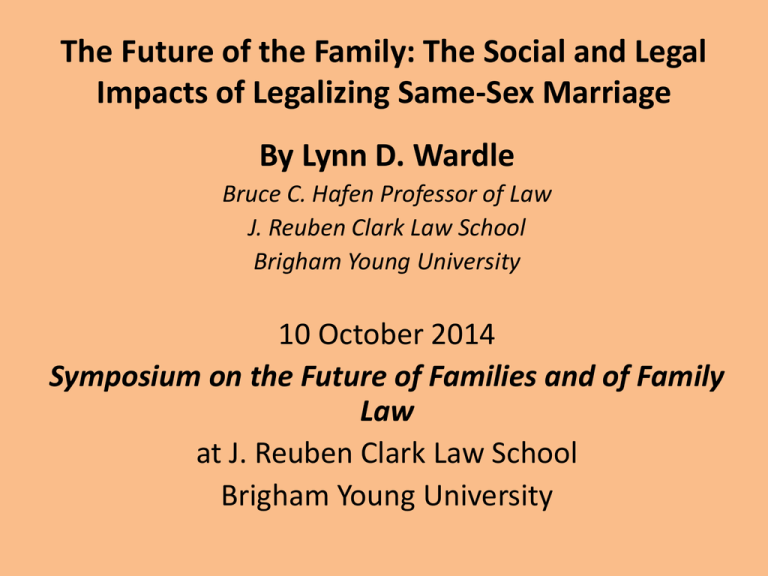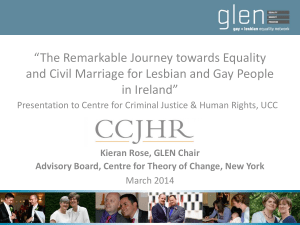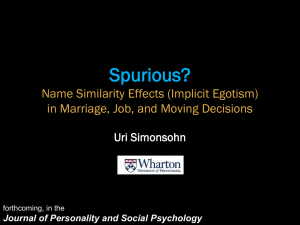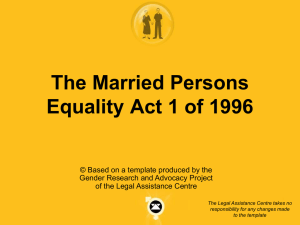
The Future of the Family: The Social and Legal
Impacts of Legalizing Same-Sex Marriage
By Lynn D. Wardle
Bruce C. Hafen Professor of Law
J. Reuben Clark Law School
Brigham Young University
10 October 2014
Symposium on the Future of Families and of Family
Law
at J. Reuben Clark Law School
Brigham Young University
Playing at BYU in
the de Jong Concert
Hall October 22-25,
2014
I. Introduction
-Marriage and family forms, structures, relationships and
meanings have changed and are changing significantly in
American society and law. Similarly, as both an effect and partial
cause of these social changes, family law, likewise, is turbulent
and confused.
-I compare and contrast the movement to legalize same-sex
marriage with the movement to invalidate anti-miscegenation
laws, to recognize “palimony” (quasi-spousal financial rights),
and to legalize abortion-on-demand. That is: Loving v. Virginia,
388 U.S. 1 (1967), Marvin v. Marvin, 557 P.2d 106 (Cal. 1976) and
Roe v. Wade, 410 U.S. 113 (1973).
-I conclude that in some very critical ways, judicial legalization of
same-sex marriage is more like Roe than Loving or Marvin, and
that it would achieve the most lasting, effective, and legitimate
law reform if it were to follow the state-by-state (preferably
legislative) reform process.
II. Trends Indicating Significant Changes in
Families and Family Law (A Decrease in Social
Recognition of the Value of, and in Social
Commitment to, Marriage and Marital Families
Some Trends of Concern:
• Child-bearing Out of Wedlock (40%) & single-parenting
• Cohabitation
• Decreased Commitment to Marriage
• High Divorce Rate
• Demographic Winter
• Decreasing International Adoption
• Same-sex Marriage
Deterioration of Marital Families
-Today, almost half of children in single-mother
homes live with never-married mothers; four
decades ago, that figure was one in 16, oneseventh of today’s figure.
-The percentage of unmarried couples living
together has increased ten-fold, from slightly
more than one percent of all couples in 1960 to
nearly 12 percent in 2011.
Nearly 12% of Couples are Cohabiting Without Marriage
http://familyfacts.org/charts/110/nearly-12-percent-of-couples-living-together-are-unmarried (seen 7 October 2014), citing U.S. Census
Bureau, Current Population Survey, 2010.
Table 1. Unmarried Cohabitants in USA, 19702010
Year
1970
1980
1990
2000
2006
2010
Unm’d P Hhlds
523,000
1,589,000
3,668,000
5,500,000
6,017,462
7,700,000
% Hhlds
0.8%
2.0%
3.1%
4.3%
5.4%
>10.1%
The Annual marriage rate has declined Significantly in the past generation
Today, the marriage rate-the annual number of marriages per 1,000 unmarried women- is less than half of what it was four decades ago.
http://familyfacts.org/charts/105/the-annual-marriage-rate-has-declined-significantly-in-the-past-generation (141007)
NUMBER OF MARRIAGES PER 1,000 WOMEN, AGE 15 AND OLDER
The Age of Marriage Has Risen Steadily Since 1960 for Both Men and Women
http://familyfacts.org/charts/102/men-and-women-are-marrying-later (seen 7 October 2014)
Percent of Married Adults, Age 14+
http://familyfacts.org/charts/150/the-proportion-of-married-adults-hasdecreased (seen 7 October 2014)
Recent marriages are slightly more lasting for men
Nearly 77 percent of men married for the first time in the early 1990s reached their 10th anniversary, three percentage points higher than
men married in the early 1980s.
http://familyfacts.org/charts/161/recent-marriages-are-slightly-more-lasting-for-men (141007)
MEN REACHING 10TH AND 20TH WEDDING ANNIVERSARIES FOR FIRST MARRIAGES
Recent marriages are slightly more lasting for women
Nearly 75 percent of women married for the first time in the early 1990s reached their 10th anniversary, nearly four percentage points higher
than women married in the mid-1970s.
http://familyfacts.org/charts/160/recent-marriages-are-lasting-longer (141007)
WOMEN REACHING 10TH AND 20TH WEDDING ANNIVERSARIES FOR FIRST MARRIAGES
Pew (2011):
Marriage Has Dropped In Importance for Young Adults in US
Wendy Want & Paul Taylor, For Millennials, Parenthood Trumps Marriage, Pew Research Center, available at
http://pewresearch.org/pubs/1920/millennials-value-parenthood-over-marriage (seen 14 March 2011).
U.S. CHILDREN BORN OUT OF WEDLOCK 1940-2010
Year
All Races
Number
Rate/1000 live
births
White Number
Rate/1000 live
births
Non-White
Number
Rate/1000 live
births
1940
89,500
38
40,300
19.5
49,200
168.3
1950
141,600
40
53,500
17.5
88,100
179.6
1960
224,300
53
82,500
22.9
141,800
215.8
1970
398,700
107
175,100
56.6
223,600
349.3
1980
665,747
184
320,063
110.4
345,684
484.5
1990
1,165,400
266
647,400
169
472,700 bl
667 bl
2000
1,347,000
332
866,000
271
427,000 bl
685 bl
2005
1,527,000
369
--
317
--
693 bl
2007
1,714,600
397
--
--
--
--
2008
--
410
--
--
--
--
2010
--
408
--
--
--
--
Birth Rate for Unmarried Nearly Rate for Married Women
The gap between married and unmarried birth rates has narrowed, The Heritage Foundation, 2011, at
http://familyfacts.org/charts/213/the-gap-between-married-and-unmarried-birth-rates-has-narrowed .
Fig. 1. Percentage of US Children born out of marriage
Source: http://familyfacts.org/charts/205/more-than-four-in-10-children-are-born-tounwed-mothers (citing U.S. Census Bureau, National Center for Health Statistics, 2010.)
Almost half of children in single-mother homes live with never-married mothers
Nearly one in two children in single-mother homes live with mothers who have never been married. Four decades ago, that figure
was one in 16, one-seventh of today’s figure.
http://familyfacts.org/charts/145/almost-half-of-children-in-single-mother-homes-live-with-never-married-mothers (141007)
LIVING ARRANGEMENTS OF CHILDREN LIVING IN MOTHER-ONLY HOUSEHOLDS SINCE 1968
REDUCTION OF CHILDBEARING:
Due to low fertility rates, a “demographic winter” is descending upon affluent nations.
British historian Niall Ferguson calls this imminent demographic change “the greatest
sustained reduction in European population since the Black Death of the 14th
Century.”
Births are below replacement level (2.1 births per couple) in over 70 nations. The
Organization for Economic Cooperation and Development (OECD) reports that none of
the nations of Europe can maintain their population (necessary for economic
sustainability) through births, that only France, (with a birth rate of 1.8) has the
possibility to do so. In fifteen European nations the rate of fertility is 1.3 or below, -(a birthrate of 1.4 or 1.5 means that the population will decrease by one-third each
generation).
The United Nations Report on World Populating Ageing 1950-2050 notes: “[T]he
average total fertility rate in the more developed regions [of the world] has dropped
from an already low level of 2.8 children per woman in 1950-1955 to an extremely low
level of 1.5 children per woman in 2000-2005. Presently, the total fertility rate is
below the replacement level in practically all industrialized countries. In 19 of those
countries, the rate is under 1.3 children per woman.”
Source: W. Bradford Wilcox & Elizabeth Marquardt, The State of Our Union; Marriage in
America 2010 (2010)at p. 21.
Number of divorces per 1,000 married women (age 15+)
http://familyfacts.org/charts/120/the-divorce-rate-is-declining-but-still-high
Nearly one-third of Americans born in the 1950s had
divorced by age 45
http://familyfacts.org/charts/165/by-age-45-about-one-in-three-americans-born-in-the-1950s-had-divored (141007)
Over ¼ of American Children < Eighteen Years-Old Living With a Single Parent
Familyfacts at http://familyfacts.org/charts/135/more-than-one-in-four-children-live-in-a-single-parenthome (141007)
More than half of all African-American chlidren live in a single-parent home
Since 1960, the percentage of African-American children living in single-parent homes
has more than doubled, from 22 percent to 53 percent.
http://familyfacts.org/charts/171/more-than-half-of-all-african-american-childrenlive-in-a-single-parent-home (141007)
BLACK CHILDREN'S LIVING ARRANGEMENTS
More than one in five white children lives in a single-parent home
Since 1960, the percentage of white children living in single-parent homes has increased from 7 percent to nearly 23 percent.
http://familyfacts.org/charts/170/more-than-one-in-five-white-children-lives-in-a-single-parent-home (141007)
WHITE CHILDREN'S LIVING ARRANGEMENTS
Despite recent declines, about two-thirds of children
live with their married biological or adoptive parents
http://familyfacts.org/charts/140/despite-recent-decline-two-thirds-of-children-live-with-married-parents- (viewed 7 October
2014)
Figure 1: Trends in Intercountry Adoption to 23 Receiving States, 2001-2010
Peter Selman, Global Trends in Intercountry Adoption: 2001-2010, National Council for
Adoption, Adoption Advocate, No. 44, February 2012. (Figure 1 & Tables 2-4 herein)
Table 1
Intercountry Adoptions in the USA from All Foreign
Countries Combined, 1999-2011
Year:
Number:
1999
2000
2001
2002
2003
2004
2005
2006
2007
2008
2009
2010
2011
Total 1999 – 2011
15,719
18,857
19,647
21,467
21,654
22,991
22,734
20,680
19,608
17,456
12,744
11,058
9,319
233,934
+
+
+
+
+
(-)
(-)
(-)
(-) *FIRST YEAR US FULLY FOLLOWS HCIA
(-)
(-)
(-)
About 2/3 = females
About 40% under 1 year old, about 35% 1-2 years old, about 25% = 3-17 years old.
Source: U.S. Department of State, Bureau of Consular Affairs, Intercountry Adoption, Year 2011 Annual Report, available at http://adoption.state.gov/about_us/statistics.php (seen 6 April 2012).
State Same-Sex Marriage Laws:
Legislatures and Courts
Source: National Conference of State Legislatures, States that Allow Same-Sex Marriage, September 7, 2014, available at
http://www.ncsl.org/research/human-services/same-sex-marriage-laws.aspx (last viewed 7 October 2014).
(ORDER LIST: 574 U.S.)
MONDAY, OCTOBER 6, 2014
CERTIORARI DENIED
....
14-124 HERBERT, GOV. OF UT, ET AL. V. KITCHEN,
DEREK, ET AL.
Source:
http://www.supremecourt.gov/orders/courtord
ers/100614zor.pdf (viewed 7 October 2014)
USA Today, 7 October 2014
USA Today, 7 October 2014
USA Today, 7 October 2014 (Balance of 31
states that adopted Constitutional
Amendments Banning SSM)
Source: Washington Post 141007 http://www.washingtonpost.com/wpsrv/special/politics/same-sex-marriage/ (141007)
Recent Developments
This week, on Monday, October 6, 2014, the
Supreme Court denied petitions for writ of
certiorari filed by five states in five separate
cases in which lower federal courts had ruled
that those states (Utah, Virginia, Oklahoma,
Wisconsin, and Indiana) were constitutionally
required to legalize same-sex marriage. The next
day the Ninth Circuit further mandated samesex marriage in Idaho and Nevada, but Justice
Kennedy has stayed that order.
Nearly 2/3 of SSCs Live in States
Where SSM Allowed (as of 141006)
U.S. Supreme Court Decision Opens Marriage ….
The Williams Institute (141007)
Gay issues find increasing acceptance
March 2014 Post-ABC Poll
•
Q: Overall, do you support or oppose allowing gays and lesbians to marry legally?
– SUPPORT
– OPPOSE
•
59%
34%
Q: Regardless of your own preference on the issue, do you think that the part of
the U.S. Constitution providing Americans with equal protection under the law
does or does not give gays and lesbians the legal right to marry?
– DOES
50%
– DOES NOT 41%
•
Q: Do you favor or oppose allowing gay or lesbian couples to adopt a child?
– FAVOR
– OPPOSE
•
61%
34%
Q: In general, do you think gay people can be as good parents as straight people,
or not?
– YES, CAN BE AS GOOD
78%
– NO, CANNOT BE AS GOOD 18%
Source: http://www.washingtonpost.com/page/20102019/WashingtonPost/2014/03/05/National-Politics/Polling/release_301.xml
Changing Attitudes on Gay Marriage, Pew Research Religion & Public Life Project, 24 September 2014, available at
http://www.pewforum.org/2014/09/24/graphics-slideshow-changing-attitudes-on-gay-marriage/ (viewed 7 October
2014).
Changing Attitudes on Gay Marriage, Pew Research Religion &
Public Life Project, 24 September 2014, available at
http://www.pewforum.org/2014/09/24/graphics-slideshowchanging-attitudes-on-gay-marriage/ (viewed 7 October 2014).
Source: Washington Post 141007 http://www.washingtonpost.com/wpsrv/special/politics/same-sexmarriage/ (141007)
Source: Washington Post 141007 http://www.washingtonpost.com/wpsrv/special/politics/same-sexmarriage/ (141007)
Source: Washington Post 141007 http://www.washingtonpost.com/wpsrv/special/politics/same-sexmarriage/ (141007)
Marriage is the Key
The core, connecting, underlying problem - the
cornerstone- concerns marriage, the
disintegration of marriage and of the concept of
marriage and marital families.
“It is marriage that makes all the difference.” –
Baroness Ruth Deech (House of Lords)
III. The Unique Public Value of
Marriage Between A Man and A
Woman
-Keep focus on objective public interests, not
subjective personal interests.
-Dual Gender Marriage society's interests in the
public welfare concerning (1) safe sexual relations,
(2) procreation and childrearing, (3) the status of
women, (4) the stability, strength, and security of
the family union, (5) the integrity of the basic unit
of society, (6) civic virtue and public morality, (7)
interjurisdictional comity, and (8) government
efficiency.
IV. Distinguishing Three Cases and
No-Fault Law Reform from Same-Sex
Marriage
Loving v. Virginia (based on constitutional Civil War amendments)
-“Approximately one in four soldiers that went to war [in the American Civil War]
never returned home.”
-“Roughly 2% of the population, an estimated 620,000 men, lost their lives in the line
of duty. Taken as a percentage of today’s population, the [death] toll would have risen
to as high as 6 million souls.”
-The total casualties in the Civil War (soldiers who died, were wounded, were
captured, or were missing) was nearly 1.5 million men.
-No question that the issue was decided as a matter of law (though long delay in full
implementation!).
- A similar super-consensus for same-sex marriage is lacking.
-Justice Ginsburg (VMI): “[T]he two sexes are not fungible; a community made up
exclusively of one [sex] is different from a community composed of both.” (quoting
Ballard v. United States).
Marvin v. Marvin (state court, state-by-state)
Roe v. Wade (most sustained scholarly/public criticism; still dubious opinion;
still illegitimate judgment)
Yale Law School Professor Alexander Bickel commented:
“One of the most curious things about Roe is that, behind its own verbal smokescreen,
the substantive judgment on which it rests is nowhere to be found.”
Harvard Law School Professor (and Watergate Special Prosecutor) Archibald Cox
wrote:
“the [Roe] opinion fails even to consider what I would suppose to be the most
compelling interest of the state in prohibiting abortion: the interest in maintaining
respect for the paramount sanctity of human life which has always been at the center
of western civilization . . . .”
Liberal Professor Mark V. Tushnet wrote:
“It seems to be generally agreed that, as a matter of simple craft, Justice Blackmun's
opinion for the Court was dreadful.”
Fordham Law School Professor Robert Byrn wrote:
“Roe v. Wade is in the worst tradition of a tragic judicial aberration that periodically
wounds American jurisprudence . . . .”
Professor John Hart Ely accused the Supreme Court of
“mistak[ing] a definition for a syllogism,” and declared:
“[Roe] is bad because it is bad constitutional law, or
rather because it is not constitutional law and gives
almost no sense of an obligation to try to be.”
University of Chicago Professor Richard Epstein criticized:
“Roe v. Wade is symptomatic of the analytical poverty
possible in constitutional litigation.”
No-Fault Divorce Reform
(1969-77)
State-by-State Legislative Reform in nearly half
the states.
In nearly all states (49 states) by 1985.
Controversial, contested but not bitter because
the democratic process allowed all to participate
in the policy formation.
No lasting-lingering hostility or resentment.
General social acceptance (and move-on).
V. Conclusion: The Past Is Prologue
-Which approach the courts will take will have significant
implications for how the issue ultimately is resolved and how
it is received by the people of America, especially those who
disagree with the policy position imposed by judicial decision.
-Grass-roots (state court) initiated legislative family law
reforms (like Marvin) have the best likelihood of success. Form
and substance are linked in family law.
-Imprudent, impulsive or impatient judicial action (ala Roe v.
Wade) may complicate the process of resolving the issue,
delay the social outcome, provoke long-lasting hostility, and
diminish respect for the courts in the process.
THANK YOU!












